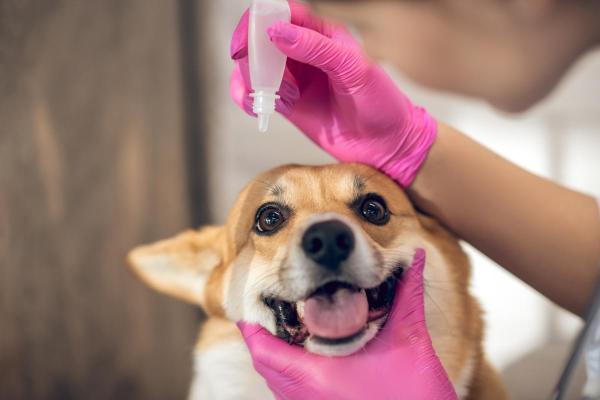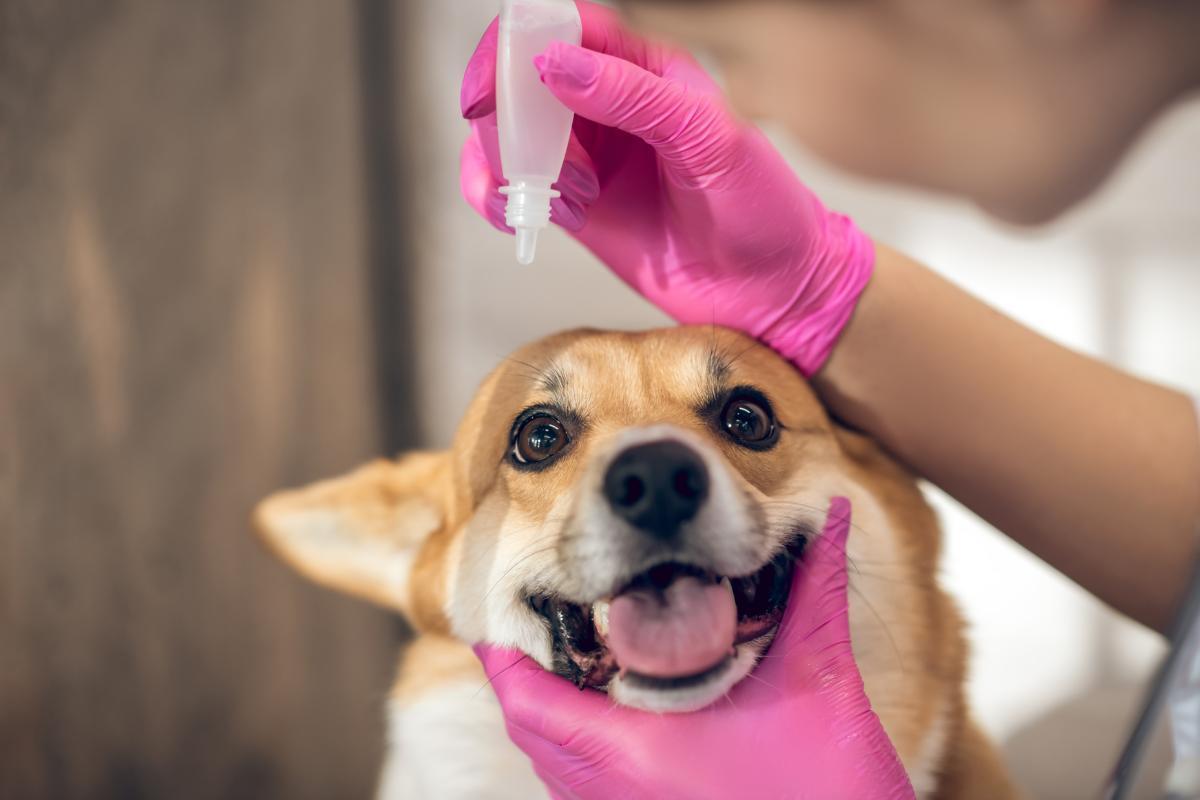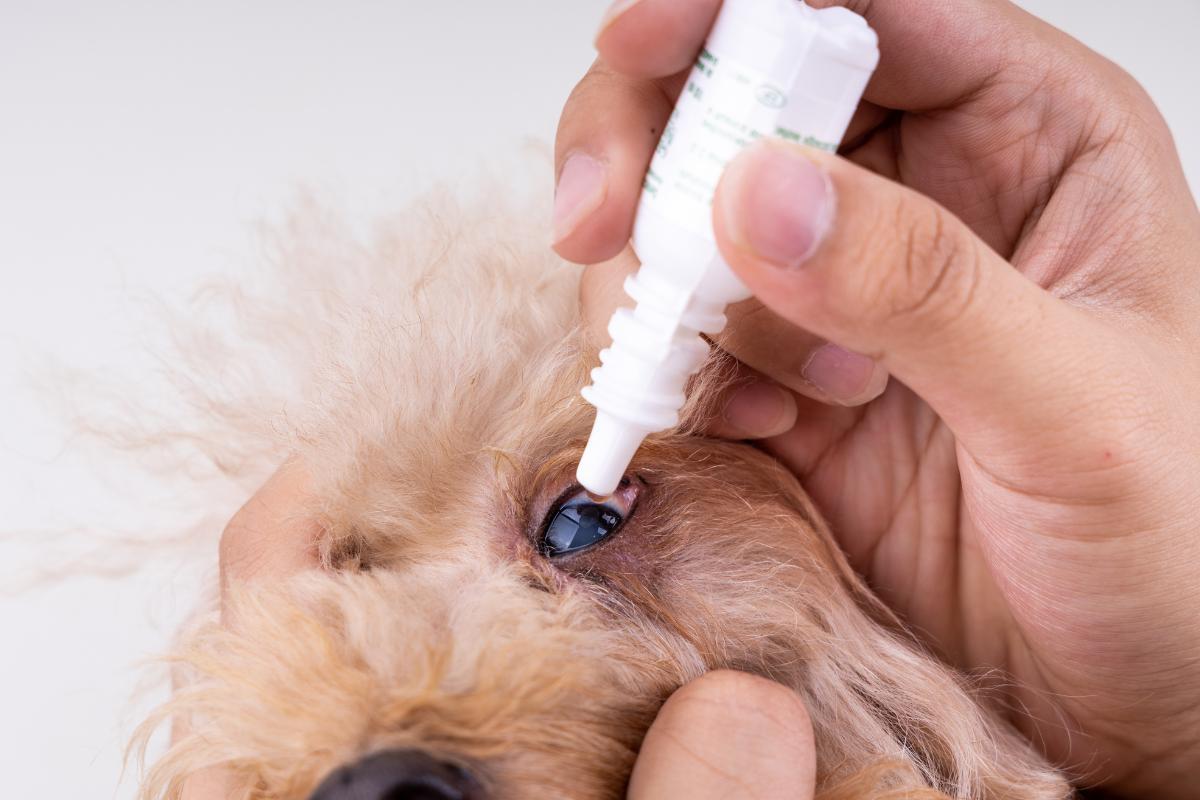Polytrim Eye Drops for Dogs



See files for Dogs
When your dog's eyes become red, swollen, and teary, it's a sign that something's amiss. Bacterial eye infections, also known as conjunctivitis, are a common ailment in dogs, causing discomfort and impaired vision. If left untreated, these infections can worsen, leading to more severe complications. Polytrim, an ophthalmic antibiotic solution, offers a safe and effective treatment for canine bacterial eye infections.
In this comprehensive AnimalWised article, we'll thoroughly explore Polytrim eye drops for dogs, exploring its dosage, applications, and potential side effects.
What is Polytrim for dogs?
Polytrim is an ophthalmic medication that is used to treat bacterial infections of the eye in dogs and cats. It is a combination of two antibiotics, polymyxin B and trimethoprim, which work together to kill bacteria that are causing the infection. Specifically, polymyxin B sulfate is an antibiotic that works by killing sensitive bacteria in the eye, while trimethoprim prevents the growth of bacteria by stopping the production of essential proteins.
Polytrim is frequently recommended by veterinarians to address issues like conjunctivitis (commonly known as pink eye) and other bacterial eye infections in dogs.
Just like with human medications, it's crucial to follow the veterinarian's instructions meticulously, finish the entire treatment as advised, and administer the medication exactly as prescribed. This helps achieve the best results and reduces the risk of antibiotic resistance or adverse effects. Always seek advice from a veterinary professional for accurate diagnosis and treatment suggestions for your dog.
Curious about caring for your dog’s eyes? Delve into our article on how to clean dog’s eyes for essential tips on maintaining your pet’s eye health.
What is Polytrim used for in dogs?
Polytrim is highly effective in treating a wide range of bacterial eye infections and related conditions in dogs. Its efficacy and versatility make it a valuable tool for veterinarians in managing various eye disorders.
Common bacterial eye infections treated with Polytrim
- Conjunctivitis: conjunctivitis, also known as pink eye, is a common bacterial infection that affects the conjunctiva, the lining of the eyelids and eyeball. Puppies and adult dogs are equally susceptible to this infection. Polytrim can effectively treat conjunctivitis, alleviating symptoms such as redness, swelling, discharge, and discomfort.
- Secondary eye infections: in cases where dogs develop secondary bacterial infections due to underlying eye conditions or injuries, Polytrim can be effectively employed to prevent or control these infections while addressing the primary issue.
- Post-traumatic eye injuries: following trauma or injuries to the eye, such as scratches or foreign objects entering the eye, veterinarians may prescribe Polytrim to prevent secondary bacterial infections and promote healing.
- Surgical aftercare: Polytrim plays a crucial role in ophthalmic surgery, both before and after procedures. It is used as a prophylactic measure to prevent bacterial infections and ensure proper healing during the post-operative period.
- Recurrent eye infections: for dogs prone to recurrent bacterial eye infections, particularly those associated with chronic conditions, Polytrim may be incorporated into a treatment plan to manage and prevent the recurrence of these infections.
Specific bacterial eye infections addressed by Polytrim
- Purulent bacterial conjunctivitis: this type of conjunctivitis is characterized by inflammation of the ocular conjunctiva, leading to symptoms such as red eyes, pus (thick yellow discharge), burning, and itching. Polytrim effectively combats this infection, alleviating these uncomfortable symptoms.
- Keratitis: keratitis refers to inflammation of the cornea, the clear outer layer of the eye. In dogs, bacterial keratitis can cause eye pain, redness, blurred vision, and sensitivity to light. Polytrim effectively treats bacterial keratitis, alleviating these symptoms and promoting corneal healing.
- Corneal ulcers: these are open erosions in the cornea that typically manifest with symptoms such as eye discharge, pain, blurred vision, and red eyes. Polytrim effectively treats corneal ulcers, promoting healing and reducing the risk of complications.
- Chronic Dacryocystitis: this condition involves prolonged inflammation of the lacrimal sac, the structure responsible for tear production. Symptoms in dogs include excessive tearing, recurrent infections, eye pain, and red eyes. Polytrim effectively treats chronic dacryocystitis, alleviating these symptoms and restoring normal tear drainage.
Keen to learn more about your dog’s eye health? Dive into our in-depth guide on conjunctivitis in dogs for insights into managing this common eye condition.
Polytrim dosage in dogs
The dosage of Polytrim for dogs varies depending on the weight of the dog and the severity of the infection.
- For dogs weighing under 4.5 kilograms (10 pounds), the typical dosage is 1-2 drops in the affected eye(s) 1-2 times per day for 7-10 days.
- For dogs weighing 4.5 kilograms (10 pounds) or more, the typical dosage is 2-3 drops in the affected eye(s) 1-2 times per day for 7-10 days.
It is important to follow the veterinarian's instructions carefully when administering Polytrim to your dog. Do not use more Polytrim than directed by your veterinarian. If you miss a dose, give the missed dose as soon as you remember, but do not give two doses at once.
If your dog's eye condition worsens or does not improve after 7-10 days of treatment, take your dog to the veterinarian.
How to apply Polytrim in my dog's eye?
Here are the steps on how to put Polytrim in your dog's eye:
- Wash your hands thoroughly with soap and water.
- Tilt your dog's head so that the affected eye is facing up.
- Gently pull down your dog's lower eyelid to create a pocket.
- Hold the Polytrim dropper so that the tip is pointing towards the pocket.
- Squeeze the dropper so that one or two drops of Polytrim fall into the pocket.
- Release your dog's eyelid and allow them to blink.
Here are some additional things to keep in mind about putting Polytrim in your dog's eye:
- The veterinarian may adjust the dosage of Polytrim based on your dog's individual needs.
- Polytrim should be stored at room temperature, away from direct sunlight.
- Keep Polytrim out of reach of children and pets.
Interested in your dog’s eye health? Explore what are the most common eye infections in dogs to dive deeper into common eye issues affecting your furry friend.

Side effects of Polytrim for dogs
Here are some of the possible side effects of using Polytrim in dogs:
- Mild redness or irritation in the eye.
- Temporary discomfort after application.
- Increased sensitivity to light.
- Allergic reactions, although these are rare.
If you notice any of the following symptoms after your dog has been given Polytrim, take them to the veterinarian immediately:
- Hives
- Difficulty breathing
- Swelling of the face, lips, or tongue
- Vomiting
- Diarrhea
In some cases, Polytrim can also cause more serious side effects, such as:
- Keratitis (inflammation of the cornea)
- Corneal ulcers
- Iritis (inflammation of the iris)
- Glaucoma (increased pressure in the eye)
To minimize the risk of side effects, it is important to use Polytrim exactly as directed by your veterinarian. Be aware of the potential side effects of Polytrim, such as redness, irritation, discomfort, or allergic reactions. If you notice any of these symptoms, consult your veterinarian immediately.
Learn more about keratitis in dogs in our other article.
Contraindications of Polytrim for dogs
As with any medication, it is important to be aware of the potential contraindications of Polytrim before using it on your dog.
- Hypersensitivity to trimethoprim or sulfamethoxazole: Dogs who are allergic to either of these antibiotics should not be given Polytrim.
- Perforating eye injuries: Polytrim should not be used in dogs with perforating eye injuries, as it can increase the risk of infection and worsen the injury.
- Pregnancy and nursing: Polytrim should not be used in pregnant or nursing dogs, as it can be absorbed systemically and potentially harm the developing puppies or kittens.
- Kidney or liver disease: Polytrim should be used with caution in dogs with kidney or liver disease, as these conditions can affect the body's ability to metabolize the antibiotic, potentially leading to toxic buildup.
This article is purely informative. AnimalWised does not have the authority to prescribe any veterinary treatment or create a diagnosis. We invite you to take your pet to the veterinarian if they are suffering from any condition or pain.
If you want to read similar articles to Polytrim Eye Drops for Dogs, we recommend you visit our Medicine category.
- Spanish Agency for Medicines and Health Products. Oftalmowell Eye Drops Solution Package Leaflet . Available at: https://cima.aemps.es/cima/dochtml/p/45030/Prospecto_45030.html






